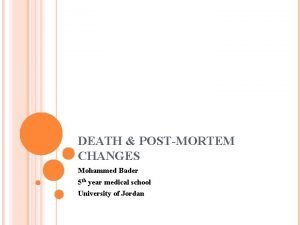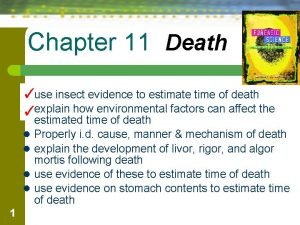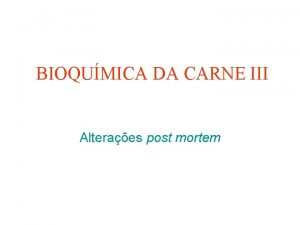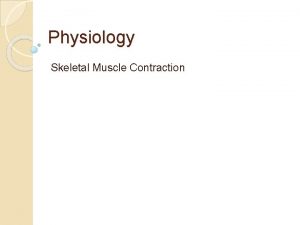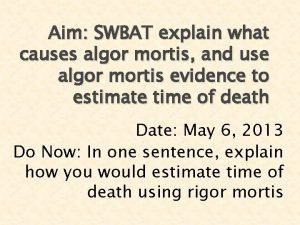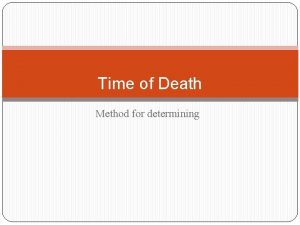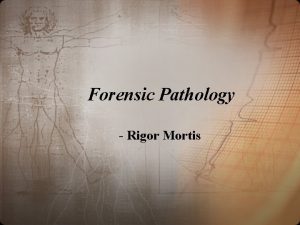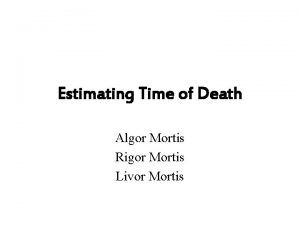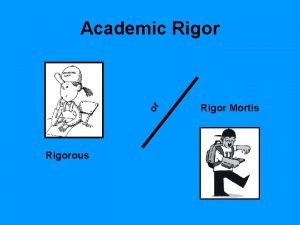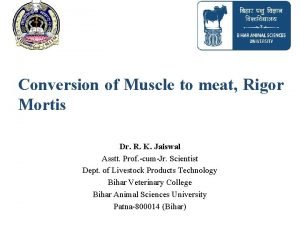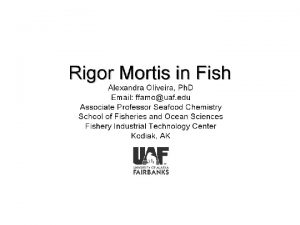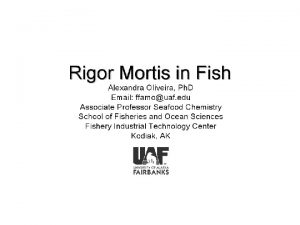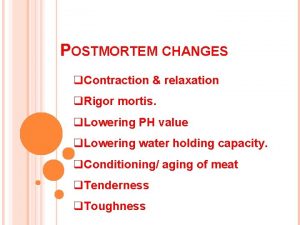Rigor Mortis Mollie Gonzalez What is Rigor Mortis











- Slides: 11

Rigor Mortis Mollie Gonzalez

What is Rigor Mortis? Why Does Rigor Mortis Occur? Autolysis; The End of Rigor Mortis Timeline Crime Scene

Ø Rigor Mortis is: Ø muscular stiffening, progresses from head to toes, that begins 2 to 4 hours after death and lasts for about 4 days

Moment of Death: 1} The heart stops 2} The skin gets tight and grey in color 3} All the muscles relax. 4} The bladder and bowels empty 5} The body's temperature will typically drop 1. 5 degrees F. per hour unless outside environment is a factor. The liver is the organ that stays warmest the longest, and this temperature is used to establish time of death if the body is found within that time frame. After 30 minutes: 6} The skin gets purple and waxy 7} The lips, finger- and toe nails fade to a pale color or turn white as the blood leaves. 8} Blood pools at the lowest parts of the body leaving a dark purple-black stain. 9} The hands and feet turn blue 10} The eyes start to sink into the skull After 4 hours: 11} Rigor mortis starts to set in 12} The purpling of the skin and pooling of blood will continue 13} Rigor Mortis begins to tighten the muscles for about another 24 hours, then will reverse and the body will return to a limp state. After 12 hours: 14} The body is in full rigor mortis. After 24 hours: 15} The body is now the temperature of the surrounding environment 16} In males, the semen dies 17} The head and neck are now a greenish-blue color 18} The greenish-blue color continues to spread to the rest of the body 19} There is the strong smell of rotting meat 20} The face of the person is essentially no longer recognizable After 3 days: 21} The gases in the body tissues form large blisters on the skin 22} The whole body begins to bloat and swell grotesquely. This process is speeded up if victim is in a hot environment, or in water 23} Fluids leak from the mouth, nose, eyes, ears and rectum and urinary opening After 3 weeks: 24} The skin, hair, and nails are so loose they can be easily pulled off the corpse 25} The skin cracks and bursts open in many places because of the pressure of Internal gases and the breakdown of the skin itself 26} Decomposition will continue until body is nothing but skeletal remains.

Ø The physiology of muscles change after one’s death. Ø ATP molecules stop working because of the lack of oxygen produced from chemical reactions. Ø Calcium pumping cells thus lose their energy, and the calcium concentration of the muscles increases. Ø The increase of calcium concentration in the muscles cause them to remain in a state of contraction. Also, since there is no available ATP, myosin and actin can’t slide away from each other. Ø When aerobic respiration ends, rigor mortis begins.


Ø Autolysis: the self-digestion of the body’s cells that occurs during rigor mortis. Ø Cell Wall: doesn’t hold up and releases its contents. Ø Autolysis is what eventually makes the muscles become limp, break down, and become soft as they decompose further, thus making rigor mortis end. Ø The muscles of the body do not relax after rigor mortis, opposed to popular belief.

Ø The position of the body when someone dies, is the same position rigor mortis occurs in. Ø For example, if a body died in bed laying on their back and their hand was raised up in the air, the body may have been tampered with. Ø The body becomes stiff in the position it died in.


Ø Using rigor mortis to estimate time of death, is an imperfect method, but useful all in the same because rigor mortis has a known time span. Ø Various factors can affect the progression of rigor mortis.

Ø Ambient Temperature: A warm climate or condition speeds up how quickly rigor mortis begins by creating an environment hospitable for bacteria and decay. A cold climate or condition slows rigor mortis down and makes it last longer. Ø Physical Exertion Immediately After Death: People who die during or after a fight, drowning, exercising, or during an exhausting activity, can have rigor mortis occur in them immediately. This happens because at the time of death the person’s muscles were already contracted, depleted of oxygen, and/or ATP. Ø Fat Distribution: Rigor mortis develops slower in fattier areas because fat acts as insulation in the body. Ø Age or Illness: People who die with a low muscle mass, like children, the elder, or someone with a disease, rigor mortis progresses at a quicker pace.
 Rigor mortis vs livor mortis
Rigor mortis vs livor mortis Livor mortis vs rigor mortis
Livor mortis vs rigor mortis Rigor mortis and livor mortis
Rigor mortis and livor mortis Rigor mortis and livor mortis
Rigor mortis and livor mortis Cadaveric spasm and rigor mortis difference
Cadaveric spasm and rigor mortis difference Algor mortis
Algor mortis Transformação do músculo em carne
Transformação do músculo em carne Myofibril
Myofibril Heat stiffening and cold stiffening
Heat stiffening and cold stiffening Time of death estimations worksheet answers livor mortis
Time of death estimations worksheet answers livor mortis Rigor mortis
Rigor mortis Casper's dictum
Casper's dictum

